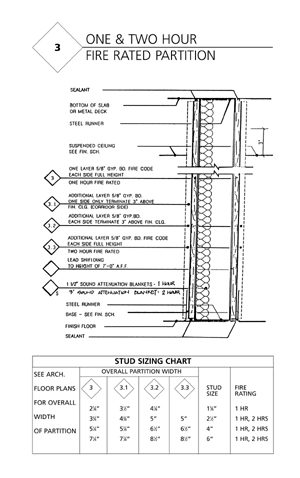
For this example (see Figure 1), the wall type is defined as a partition. As previously discussed, in drywall construction, a partition is defined as a single row of framing with gypsum board applied and finished on both sides of the framing. This wall, in all its variations, meets that criteria. At first glance, it appears that there are two basic types of wall here, one- and two-hour rated, with the stud size providing most of the variation.
This example is atypical in three fundamental ways. First, it includes a stud-sizing chart. It is more common for the variation in stud size, gauge and spacing (OC) to be noted along with the written text description adjoining the graphic description of the wall type. Second, the graphic description of the wall is a full, vertical section of the wall. More common is a graphic depicting the wall in three distinct sections as it would appear at the base, plan and head condition(s). Our example shows the base and head condition but not a plan section (a horizontal cut through the wall). Last, the text and graphic description for wall types <3.1> and <3.2> show a condition whereby the gypsum board terminates 3 inches above the finished ceiling. It is a more common requirement for the gypsum board to terminate 6 inches AFC.
There appears to be a conflict between the stud-sizing chart, the text description of each wall type and the generic description of the series at the top (<3> one- and two-hour fire-rated partition). From the latter and the stud-sizing chart, it would appear that all walls are fire rated. The stud-sizing chart confuses the issue by its location. It is not specific to the wall types but rather to the various stud size variations that are irrelevant to the rating achieved by the assembly. The fire rating(s) should have been located at the bottom of each wall type (columns) on the chart. This would have made the fire rating required and achieved wall-type specific. To add to this confusion, only wall types <3> and <3.3> are denoted in the textual description specifically as one- and two-hour rated respectively. Wall types <3.1> and <3.2> do not appear on the surface to be fire-rated. Unlike <3> and <3.3>, they do not state a required fire rating and/or denote fire-code (type X core) gypsum board that is necessary to achieve the fire rating.
Snafu avoided
Since this is an ambiguous situation that concerns life safety, it is best and safest to assume this was an oversight and in fact, wall types <3>, <3.1> and <3.2> are all one-hour rated and <3.3> alone is two-hour rated. As discussed last month, the practice of standardizing the use of fire-rated gypsum board panels throughout a job for both rated and non-rated gypsum board panels would in effect make these walls rated. Thus, a major foul can be avoided by recognition of this potential conflict in the estimating phase. I believe that <3.1> and <3.2> are not fire rated. The principle of CYA is ever present in the estimating process-this is a good example of that principle in practice.
The additional layer of gypsum board on one or both sides of the wall is shown graphically by a dotted line. Without carefully reading the textual description(s), it would appear that these additional layers are required to go full height (to underside of deck): not so. Only type <3.3> is required to go full height, types <3.1> and <3.2> are only required to go AFC. The text description confirms this.
When you come to a fork in the road, take it!
Besides the ambiguous and conflicting information given, there is also ambiguity created by the lack of information. Nowhere is the gauge and/or spacing requirement given. As we saw last month, the architect had used the limiting height criteria to determine and denote the GA/OC requirement; in that case, to an unusual extent. Here, both the GA/OC requirement and limiting height criteria are missing completely. As such, it will be up to the estimator to determine the GA/OC based on a review of the specifications, the actual deck heights (as established by the height schematic diagram) and/or limiting height criteria from manufacturers literature. For now, the GA/OC and LH shall remain "to be determined."Although the stud-sizing chart indicates the actual wall thickness, missing is an indication of the nominal wall thickness. When conflicts occur on the plan(s), a wall thickness dimension can help determine the wall type. It is also important for determining the "throat" opening for a door frame. It is the nominal rather than the actual dimension that is used most often on the plans to indicate wall thickness, but not always. It could be that, in this case, the actual dimension is being used on the plan(s) to indicate the wall thickness.
No mention is made of any special requirement at the top or head of the partition where it meets the deck for maintaining and achieving the fire rating. Depending on the type of structural deck, there could be a steel plate, safing insulation and/or smoke sealant, etc., required. Also, a deflection or long- and deep-leg track that would allow vertical movement of the wall is not indicated. A further review of the specifications and/or details on the drawings would be required to determine the need and presence of these items. With the imposition of earthquake resistance requirements into many building codes, deflection tracks have become fairly standard.
Next month, we will continue our discussion of this example. We will examine the components of the various assemblies and how a wall-type schematic schedule is used to define and further explain this variety of wall types.



Report Abusive Comment